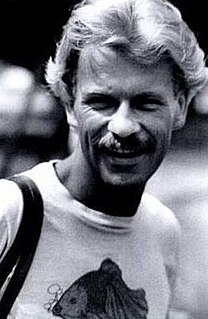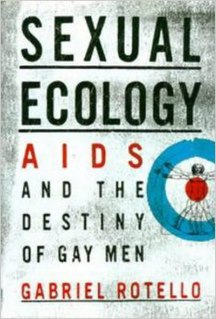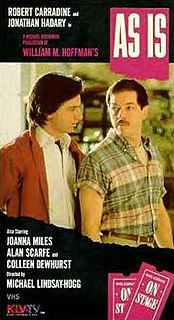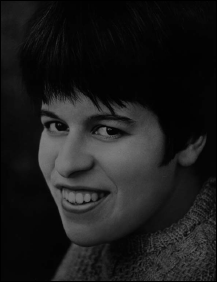
Gaëtan Dugas, a Canadian flight attendant, was a relatively early HIV patient who once was widely regarded as "patient zero" or the primary case for AIDS in the United States; his case was later found to have been only one of many that began in the 1970s, according to a September 2016 study published in Nature.
The GMHC is a New York City–based non-profit, volunteer-supported and community-based AIDS service organization whose mission statement is "end the AIDS epidemic and uplift the lives of all affected."
The President's Commission on the HIV Epidemic was a commission formed by President Ronald Reagan in 1987 to investigate the AIDS pandemic. It is also known as the Watkins Commission for James D. Watkins, its chairman when the commission issued its final report in 1988.
This is a timeline of AIDS, including AIDS cases before 1980.

AIDS is caused by a human immunodeficiency virus (HIV), which originated in non-human primates in Central and West Africa. While various sub-groups of the virus acquired human infectivity at different times, the global pandemic had its origins in the emergence of one specific strain – HIV-1 subgroup M – in Léopoldville in the Belgian Congo in the 1920s.

Robert Boyle "Bobbi" Campbell Jr. was a public health nurse and an early United States AIDS activist. In September 1981, Campbell became the 16th person in San Francisco to be diagnosed with Kaposi's sarcoma, when that was a proxy for an AIDS diagnosis. He was the first to come out publicly as a person with what came to be known as AIDS, writing a regular column in the San Francisco Sentinel, syndicated nationwide, describing his experiences and posting photos of his KS lesions to help other San Franciscans know what to look for, as well as helping write the first San Francisco safer sex manual.
Douglas Gabriel Rotello is an American musician, writer and filmmaker. He created New York's Downtown Divas revues in the 80s, was the co-founder and editor-in-chief of OutWeek Magazine, became the first openly gay columnist at a major American newspaper, New York Newsday, and authored the book Sexual Ecology. He now makes documentaries for HBO, The History Channel and other networks.

Sexual Ecology: AIDS and the Destiny of Gay Men is a 1997 book by the gay activist Gabriel Rotello, in which the author discusses why HIV has continued to infect large numbers of gay men despite the widespread use of condoms and why many experts believe that new HIV infections will disproportionately strike gay men into the future. To investigate this, he examines the origins and history of the AIDS epidemic, and draws upon epidemiology, sociology, gay history, ecology and many other disciplines. His conclusion is that gay men need to add a strategy of partner reduction to the strategy of condoms in order to bring new infections down.

As Is is a play written by William M. Hoffman.
Joseph Adolph Sonnabend is an Afrikaans physician, scientist and HIV/AIDS researcher, notable for pioneering community-based research, the propagation of safe sex to prevent infection, and an early multifactorial model of AIDS.

And the Band Played On is a 1993 American television film docudrama directed by Roger Spottiswoode. The teleplay by Arnold Schulman is based on the best-selling 1987 non-fiction book And the Band Played On: Politics, People, and the AIDS Epidemic by Randy Shilts.

The New York Native was a biweekly gay newspaper published by Charles Ortleb in New York City from December 1980 until January 13, 1997. It was the only gay paper in New York City during the early part of the AIDS epidemic, and pioneered reporting on AIDS when most others ignored it. The paper subsequently became known for attacking the scientific understanding of HIV as the cause of AIDS and endorsing HIV/AIDS denialism.
Richard Berkowitz is a gay American author and activist best known as an early advocate of safe sex in response to the AIDS crisis among gay men in the 1980s. The award-winning 2008 documentary Sex Positive directed by Daryl Wein is about his life and activities.
Lawrence D. Mass, M.D. is an American physician and writer. A co-founder of Gay Men's Health Crisis, he wrote the first press reports on the epidemic that later became known as AIDS. He is the author of numerous publications on HIV, hepatitis C, STDs, gay health, psychiatry and sex research, and on music, opera, and culture. He is also the author/editor of four books/collections. In 2009 he was in the first group of physicians to be designated as diplomates of the American Board of Addiction Medicine. Since 1979, he has lived and worked as a physician in New York City, where he resides with his life partner, writer and activist Arnie Kantrowitz. Having written for the New York Native since the 1970s, he currently writes a column for The Huffington Post. An archival collection of his papers are at the New York Public Library.
Sex Panic!, sometimes rendered SexPanic! or Sex Panic, was a sexual activism group founded in New York City in 1997. The group characterized itself as a "pro-queer, pro-feminist, anti-racist direct action group" campaigning for sexual freedom in the age of AIDS. It was founded to oppose both mainstream political measures to control sex, and elements within the gay community who advocated same-sex marriage and the restriction of public sexual culture as solutions to the HIV crisis. The group has been depicted as a faction in a gay "culture war" of the late 20th and early 21st centuries.

And the Band Played On: Politics, People, and the AIDS Epidemic is a 1987 book by San Francisco Chronicle journalist Randy Shilts. The book chronicles the discovery and spread of the human immunodeficiency virus (HIV) and acquired immune deficiency syndrome (AIDS) with a special emphasis on government indifference and political infighting—specifically in the United States—to what was then perceived as a specifically gay disease. Shilts' premise is that AIDS was allowed to happen: while the disease is caused by a biological agent, incompetence and apathy toward those initially affected allowed its spread to become much worse.

How to Have Sex in an Epidemic: One Approach is a 1983 nonfiction manual by Richard Berkowitz and Michael Callen, under the direction of Joseph Sonnabend, to advise men who have sex with men (MSM) about how to avoid contracting the infecting agent which causes AIDS. It was among the first publications to recommend the use of condoms to prevent the transmission of STDs in men having sex with men, and has even been named, along with Play Fair!, as one of the foundational publications in the advent of modern safe sex.

Linda Jane Laubenstein was an American physician and early HIV/AIDS researcher. She was among the first doctors in the United States to recognize the AIDS epidemic of the early 1980s; she co-authored the first article linking AIDS with Kaposi's sarcoma.
The portrayal of HIV and AIDS in the media refers to events and trends in the discussion of HIV and AIDS in mass media. HIV leads to a large amount of illness and many deaths. It is unique from most other diseases because there is stigma and discrimination surrounding those affected with the disease. The transmission of HIV, however, is extremely preventable and the media is a very effective way to convey this information. The UNESCO report on Journalism Education says, “Well researched television content can create public awareness about HIV prevention, treatment, care and support can potentially influence the development and implementation of relevant policies.”
New York City was more affected by the AIDS epidemic of the 1980s than any other American city. The AIDS epidemic has been and continues to be highly localized due to a number of complex socio-cultural factors that affect the interaction of the populous communities that inhabit New York.










